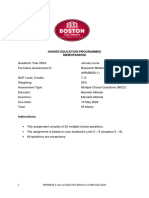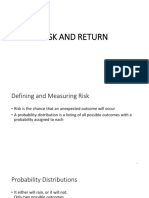0 ratings0% found this document useful (0 votes)
4 viewsAssignment For Computer Scie Year II Students
This document is an assignment for Year II Computer Science students at Hawassa University, focusing on descriptive statistics and data interpretation. Students are required to collect a dataset, perform various statistical calculations, create visualizations, and reflect on the implications of their findings. The assignment includes specific questions related to data analysis, interpretation, and real-world applications of statistics, with a due date of December 17, 2024.
Uploaded by
Mintesnot YigezuCopyright
© © All Rights Reserved
Available Formats
Download as PDF, TXT or read online on Scribd
0 ratings0% found this document useful (0 votes)
4 viewsAssignment For Computer Scie Year II Students
This document is an assignment for Year II Computer Science students at Hawassa University, focusing on descriptive statistics and data interpretation. Students are required to collect a dataset, perform various statistical calculations, create visualizations, and reflect on the implications of their findings. The assignment includes specific questions related to data analysis, interpretation, and real-world applications of statistics, with a due date of December 17, 2024.
Uploaded by
Mintesnot YigezuCopyright
© © All Rights Reserved
Available Formats
Download as PDF, TXT or read online on Scribd
You are on page 1/ 2
HAWASSA UNIVERSITY
DEPARTMENT OF STATISTICS
Name: _________________________________________ID:_______________ Date: Dec 2024
INTRODUCTION TO STATISTICS
For Computer Science Year II Students
December 2024
Assignment: Descriptive Statistics and Data Interpretation
Due Date: 17/12/2024
Total Marks: 20
Questions:
1. Data Collection:
Collect a dataset of 30 observations on a variable of your choice (e.g., age, height, weight,
hours of study) in your class. List the raw data clearly.
A) Organize the Data (5 marks):
a) Create a frequency table for your dataset.
b) Group the data into intervals (if applicable).
B) Calculate the following for your dataset:
a) Mean
b) Median
c) Mode
C) Compute the following:
a) Range
b) Variance
c) Standard Deviation
D) Data Visualization (5 marks):
a) Construct a bar chart or histogram for the data.
b) Ensure proper labeling of axes and intervals.
E) Interpretation of Results (5 marks): Based on your calculations, answer the following:
a) What does the mean represent in this context?
b) How do the range, Variance and standard deviation help in understanding the spread
of data?
F) Describe the distribution shape based on the graph. Is it symmetric, skewed, or
uniform? Explain your reasoning.
2. Reflect on how descriptive statistics can help in real-life decision-making. Provide
one example related to your field of study or interest.
HAWASSA UNIVERSITY
DEPARTMENT OF STATISTICS
Name: _________________________________________ID:_______________ Date: Dec 2024
3. Explain the significance of a small versus a large standard deviation in a dataset. Provide
an example for each case.
4. Choose a real-world example (e.g., income, exam scores, or sales data):
Describe how each measure of central tendency could be used.
Highlight potential drawbacks for each measure in your chosen context.
5. The following data shows the salaries (in $1,000) of employees in two departments:
Department A: 40, 45, 50, 55, 60, 40, 45, 50, 55, 60, 40, 45, 50, 55, 60
Department B: 30, 35, 40, 45, 150, 30, 35, 40, 45, 150, 30, 35, 40, 45, 150
a) Compute the mean, median, and mode for both departments.
b) Discuss which measure gives a better understanding of the salary distribution
in each department.
6. Explain why the mode might be less useful for continuous data. Provide an example of a
dataset where the mode is not meaningful.
7. Explain how the mean is affected by outliers. Give an example of a situation where using
the mean leads to misleading conclusions.
8. Why is the coefficient of variation (CV) a useful tool for comparing variability across
datasets with different units? What are its limitations?
9. List two drawbacks of using the range as a measure of variation.
10. A study measures the monthly income of two groups of workers. Group A's income data
is tightly clustered, while Group B's data has significant variability. Suggest the most
appropriate measure of variation to describe each group and justify your answer.
11. A researcher analyzes two datasets and finds that one has a larger standard deviation but a
smaller IQR. What does this suggest about the distribution of data in the two datasets?
Can a dataset have a small variance but a large range? Justify your answer with an
example.
You might also like
- 18Pmbf10 Application of Spss in Research 2 0 2 2No ratings yet18Pmbf10 Application of Spss in Research 2 0 2 214 pages
- Advance Data Analyses (PBP 10203) Test For Sem 2 Session 2017/2018No ratings yetAdvance Data Analyses (PBP 10203) Test For Sem 2 Session 2017/20184 pages
- DBB2102 – QUANTITATIVE TECHNIQUES FOR MANAGEMENTNo ratings yetDBB2102 – QUANTITATIVE TECHNIQUES FOR MANAGEMENT15 pages
- STAT1008 - S1 2024 - Assignment InstructionsNo ratings yetSTAT1008 - S1 2024 - Assignment Instructions6 pages
- Tutor Test and Home Assignment Questions For deNo ratings yetTutor Test and Home Assignment Questions For de4 pages
- Practice Problems On Descriptive StatisticsNo ratings yetPractice Problems On Descriptive Statistics4 pages
- Universiti Teknikal Malaysia Melaka Fakulti Kejuruteraan Mekanikal SEMESTER I 2011/2012No ratings yetUniversiti Teknikal Malaysia Melaka Fakulti Kejuruteraan Mekanikal SEMESTER I 2011/20123 pages
- HRMB330-1-Jan-Jul 2024-FA2-Memo-V.3-MM-10112023No ratings yetHRMB330-1-Jan-Jul 2024-FA2-Memo-V.3-MM-1011202327 pages
- Data Gathering, Organization, Presentation and InterpretationNo ratings yetData Gathering, Organization, Presentation and Interpretation10 pages
- CS 8031 Data Mining and Data Warehousing TutorialNo ratings yetCS 8031 Data Mining and Data Warehousing Tutorial9 pages
- Updated Cs3352 - Foundations of Data Science - DuraimuruganNo ratings yetUpdated Cs3352 - Foundations of Data Science - Duraimurugan16 pages
- Data Analysis of Students Marks With Descriptive StatisticsNo ratings yetData Analysis of Students Marks With Descriptive Statistics4 pages
- Styled_Statistics_Questions_with_Answers.pdfNo ratings yetStyled_Statistics_Questions_with_Answers.pdf3 pages
- Assignment 2 MPU3373 Analytics Report EXCEL Dashboard (UFM July 2023 Semester)No ratings yetAssignment 2 MPU3373 Analytics Report EXCEL Dashboard (UFM July 2023 Semester)2 pages
- Statistics Assignment 231016 141927 231017 195120No ratings yetStatistics Assignment 231016 141927 231017 1951202 pages
- BIA 658 Social Network Analysis - Midterm Exam Fall 2020No ratings yetBIA 658 Social Network Analysis - Midterm Exam Fall 20203 pages
- Assignment/ Tugasan - Statistics/StatistikNo ratings yetAssignment/ Tugasan - Statistics/Statistik10 pages
- BPCC 104 E 2023 24 GSPH@9891268050 EhbkyuNo ratings yetBPCC 104 E 2023 24 GSPH@9891268050 Ehbkyu17 pages
- ENT300 - Final Project - Fresh Chicken FarmNo ratings yetENT300 - Final Project - Fresh Chicken Farm163 pages
- Measure of Dispersion Kurtosi, SkiwnessNo ratings yetMeasure of Dispersion Kurtosi, Skiwness22 pages
- Working Capital Management in Indian Steel Industry: A Case Study of SailNo ratings yetWorking Capital Management in Indian Steel Industry: A Case Study of Sail6 pages
- HSC Chemistry 7.0 User's Guide: Mass Balancing and Data ReconciliationNo ratings yetHSC Chemistry 7.0 User's Guide: Mass Balancing and Data Reconciliation50 pages
- F CA-drawframes Combingsection Lowres MarzoliNo ratings yetF CA-drawframes Combingsection Lowres Marzoli32 pages
- QBM 101 Business Statistics: Department of Business Studies Faculty of Business, Economics & Accounting HE LP UniversityNo ratings yetQBM 101 Business Statistics: Department of Business Studies Faculty of Business, Economics & Accounting HE LP University62 pages
- INMATEH-Agricultural Engineering 47 2015 PDFNo ratings yetINMATEH-Agricultural Engineering 47 2015 PDF180 pages
- A Class MTH302 MCQ's Solved by Rana Umair A Khan100% (3)A Class MTH302 MCQ's Solved by Rana Umair A Khan14 pages
- Boron Determination in Plant Azomethine HNo ratings yetBoron Determination in Plant Azomethine H12 pages
- ASTM - G57 - 2001 Measurement of Soil ResistivityNo ratings yetASTM - G57 - 2001 Measurement of Soil Resistivity5 pages
- Average Relative Error in Geochemical Determinations: Clarification, Calculation, and A Plea For ConsistencyNo ratings yetAverage Relative Error in Geochemical Determinations: Clarification, Calculation, and A Plea For Consistency11 pages
- Housing Deficit - Methodology and GuideNo ratings yetHousing Deficit - Methodology and Guide45 pages
- ISRM-EUROCK-2012-157 - Dealing With Epistemic Uncertainty in Fractured Rock MassesNo ratings yetISRM-EUROCK-2012-157 - Dealing With Epistemic Uncertainty in Fractured Rock Masses13 pages

























































































